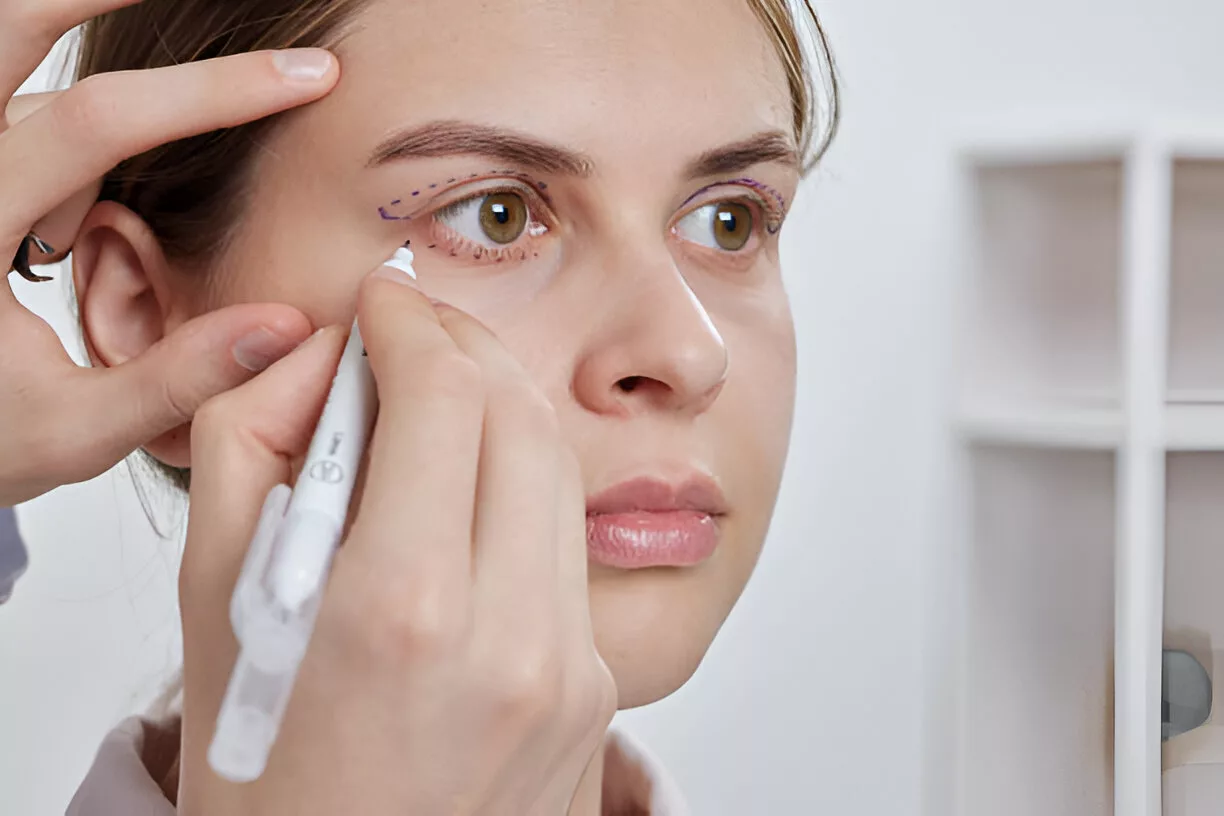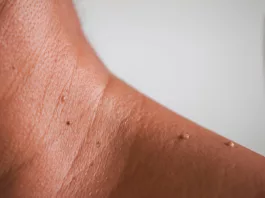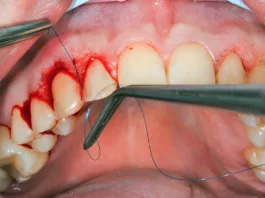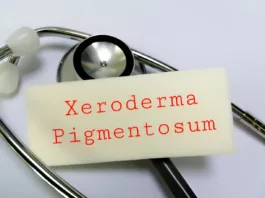Blepharoplasty is a surgical procedure that addresses droopy or sagging eyelids caused by aging and rejuvenates the appearance of the eyes. Eyelids stretch with age, and the muscles that support them weaken. As a result, extra skin and fat may accumulate above and below the eyelids. This can lead to sagging brows, droopy upper lids, and under-eye bags. In some cases, significantly drooping skin around the eyes can impair peripheral vision, especially in the upper and outer areas of the visual field. Blepharoplasty may help reduce or eliminate these visual impairments. The procedure can also make the eyes appear more youthful and alert.1Papadopulos NA, Hodbod M, Henrich G, Kovacs L, Papadopoulos O, Herschbach P, Machens HG. The Effect of Blepharoplasty on Our Patients’ Quality of Life, Emotional Stability, and Self-Esteem. J Craniofac Surg. 2019 Mar/Apr;30(2):377-383.
What Is Blepharoplasty?
Blepharoplasty is a cosmetic procedure used to improve the appearance of the eyes. It may involve the removal of excess skin, muscle, and fat in order to improve the appearance of the eyes aesthetically.2Pan L, Sun Y, Yan S, Shi H, Jin T, Li J, Zhang L, Wu S. A Flexible Suspension Technique of Blepharoplasty: Clinical Application and Comparison with Traditional Technique. Aesthetic Plast Surg. 2019 Apr;43(2):404-411.
Upper Blepharoplasty:
Upper blepharoplasty refers to the surgical repair or reconstruction of the upper eyelid, which includes the management of excess upper eyelid skin (dermatochalasis), underlying ptosis, the orbital septum, and redundant or inadequate preaponeurotic and medial orbital fat.
Dermatochalasis can lead to both aesthetic concerns and functional problems. These may include difficulty elevating the upper eyelids, reduced peripheral vision, periorbital discomfort, and dry eyes. In patients with ptosis, the overuse of the occipitofrontalis muscles can also result in tension-type headaches.
Surgical excision of the excess upper eyelid skin may improve various features, including the field of view, quality of life, and dryness of the eyes. Additionally, upper blepharoplasty may reduce the electrical activity of the frontalis muscles, which helps alleviate forehead muscle strain and related headaches.
Lower Blepharoplasty:
Like the upper eyelids, the lower eyelids are prone to the effects of aging. The skin in this area thins with age, and the connective and soft tissues under the eye bulge and puff up into unattractive bags. Fluid may also accumulate in these areas, exacerbating the appearance of under-eye bags.
Lower eyelid blepharoplasty has long been used to treat the unwanted course of aging lower eyelids. This is a tried and tested procedure that produces good cosmetic effects and beneficial changes in repairing aging periorbital tissues around the brow and cheek for a more youthful facial appearance.
There are two main approaches for lower blepharoplasty: transcutaneous and transconjunctival. The transconjunctival method is often favored due to its quicker recovery, reduced risk of visible scarring, and lower likelihood of postoperative ectropion. However, it is not always a replacement for the transcutaneous approach. Modern lower blepharoplasty techniques often adopt a tissue-preserving strategy that includes orbital fat repositioning, sub-orbicularis oculi fat (SOOF) relocation, and fat grafting to restore lost volume and natural contour.3Zhou, Q., Wu, S., Zeng, Y., & Li, M. (2017). A comparison of the safety and efficacy of transconjunctival and transcutaneous approaches for lower blepharoplasty. Facial Plastic Surgery, 33(6), 650-655. https://doi.org/10.1055/s-0037-1603140
Who is a good candidate for Blepharoplasty?
Individuals aged 30 years or older who are in good overall health and have no major eye conditions are typically considered ideal candidates for blepharoplasty. People with the following concerns are especially suited for the procedure:
- Droopy eyelids, caused by aging or muscular dehiscence that make you look tired.
- Sagging eyelids that interfere with your vision.
- Dissatisfaction with the shape or contour of your eyelids.
- Puffy upper lids or noticeable bags under the eyes.
Eyelid surgery can enhance your appearance and boost your confidence, but it’s important to have realistic expectations. Blepharoplasty won’t drastically change your facial structure. Natural asymmetries—like slightly uneven eyes—are common and develop early in life. The goal of blepharoplasty is refinement, not transformation. Before undergoing the procedure, it’s important to understand your own facial features and to have a clear, honest conversation with your surgeon about your expectations.
Who is not an ideal candidate for Blepharoplasty?
While blepharoplasty is a common cosmetic procedure, not everyone is a suitable candidate for it. The following conditions may increase risks or limit the effectiveness of the procedure:
- Glaucoma
- Dry eyes or a detached retina
- Graves disease
- Thyroid under- or overactivity
- Cardiovascular illness
- Hypertension
- Diabetes
- Circulatory disorders
These factors determine whether you are a good candidate for blepharoplasty or not. Your doctor will consider your medical history, inspect your eyelids, and explain to you the potential risks and advantages.
How to Prepare for Blepharoplasty?
Before blepharoplasty, your doctor will evaluate your overall health and eye condition to ensure the procedure is safe for you. A full eye exam is often recommended to assess vision, check for dry eyes, and rule out underlying problems like glaucoma or blocked tear ducts. Common tests include:4Pemberton JD, Salter M, Fay A, Thuro B, Spencer H, Dajani O. Investigation of Goldmann perimetry in evaluation of patients for upper eyelid blepharoplasty. Orbit. 2018 Feb;37(1):48-52.
- Schirmer’s test, which measures tear production to detect dry eye risk.
- Visual field testing, to determine if sagging skin affects your sight.5Hacker HD, Hollsten DA. Investigation of automated perimetry in the evaluation of patients for upper lid blepharoplasty. Ophthalmic Plast Reconstr Surg. 1992;8(4):250-5.
- Jones test, to check for tear duct blockages.
You should inform your doctor about any medical conditions such as thyroid disease, diabetes, high blood pressure, or bleeding disorders. You may be advised to stop smoking, avoid blood-thinning medications, and arrange for someone to assist you after surgery. Following these steps helps reduce complications and supports a smoother recovery.
Blepharoplasty Procedure
First and foremost, your surgeon will administer either a local or general anesthetic, depending on what’s most appropriate for your case. The entire procedure typically takes around 2 hours if both upper and lower eyelids are being addressed.
If all four eyelids are being treated, the surgeon usually begins with the upper lids. Incisions are made along the natural creases of the upper eyelids. Through these incisions, the surgeon separates the skin from the underlying tissue and removes excess fat, skin, and muscle if needed. The incisions are then closed with very fine stitches. Stitches on the upper eyelids are usually removed within 3 to 6 days.
Lower eyelid blepharoplasty can be performed using different techniques. One approach involves making an incision inside the lower eyelid (transconjunctival method) to remove or reposition fat—this technique leaves no visible scar. A CO₂ or erbium laser may be used afterward to smooth fine wrinkles.
Another technique involves an external incision just below the lash line (transcutaneous approach), allowing the surgeon to remove excess skin, fat, or loose muscle. These external incisions typically heal well and fade over time. In some cases, your surgeon may also recommend laser resurfacing to enhance results and smooth the skin further.
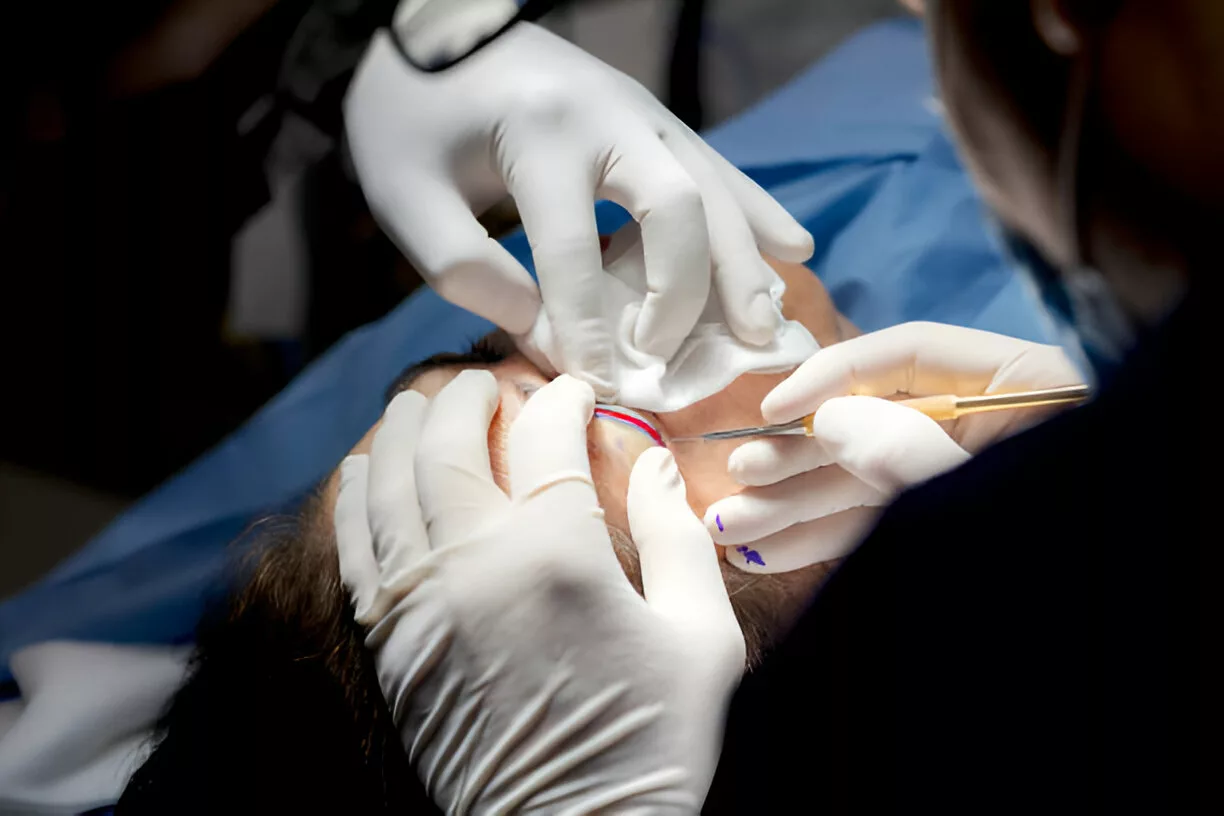
What to expect after Blepharoplasty?
Blepharoplasty typically takes 1-2 hours if both the upper and lower eyelids are treated simultaneously, depending on whether fat repositioning or additional procedures, such as cheek elevation, are required. For the upper eyelids, sutures are usually placed and will be removed in about a week. If the incision is made on the inside of the lower eyelid (transconjunctival approach), no external stitches are necessary. Swelling and bruising around the eyes are common and will gradually subside.
While the upper eyelids may take a little longer to heal, they typically show significant improvement within one to two weeks. The incision lines on the upper eyelids will be visible for a while but will eventually fade. Expect to miss work and limit your activities for several days following surgery to allow for healing. After surgery, some individuals develop dry eyes (Xerophthalmia), but the symptom seldom lasts more than two weeks. Consult your doctor if you experience dry eyes for more than two weeks.6Zhang SY, Yan Y, Fu Y. Cosmetic blepharoplasty and dry eye disease: a review of the incidence, clinical manifestations, mechanisms, and prevention. Int J Ophthalmol. 2020 Mar 18;13(3):488-492. doi: 10.18240/ijo.2020.03.18. PMID: 32309188; PMCID: PMC7154208.
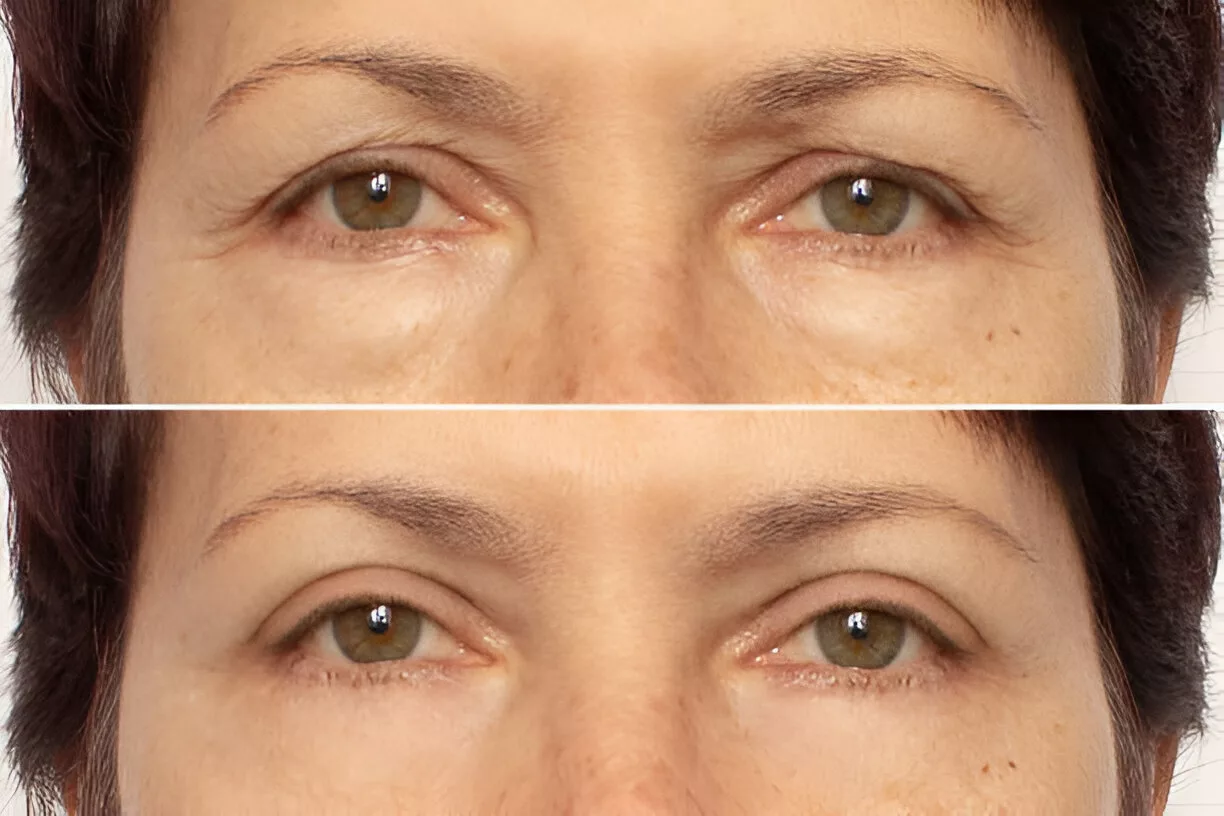
How long does it take to recover?
- Most individuals feel minor discomfort after the surgery.
- Non-dissolvable sutures are removed in the next 5-7 days, following surgery.
- Physical exercise can be progressively resumed 2-4 weeks after surgery.
- Bruising normally fades after about two weeks.
- Immediately following surgery, apply an ice compress for 72 hours, followed by a warm compress.
- After one week, you may return to work. If you want to hide the extent of your swelling, wearing thick-framed glasses may be beneficial.
- You should be able to drive within 1-2 weeks of surgery.
Risks Associated with Eyelid Surgery?
There are possible risks that come with every surgery. A few potential risks7Lelli Jr, Gary J., and Richard D. Lisman. “Blepharoplasty complications.” Plastic and Reconstructive Surgery 125.3 (2010): 1007-1017. associated with Blepharoplasty are listed below.
- Following eyelid surgery, temporary vision abnormalities such as double or blurred vision may occur. This usually only lasts a few days after the surgery.
- Problems with eye closure – Some people may have difficulties closing their eyes when sleeping in rare situations; this condition may be permanent.
- Swelling or asymmetry – During the healing or scarring process, transient swelling and a slight imbalance of one eye with respect to the other may occur.
- Ectropion is the dragging down of the lower lids, which is a sporadic problem. Additional surgery may be required to correct this issue.8Castañares S. Ectropion after blepharoplasty: prevention and treatment. Aesthetic Plast Surg. 1978 Dec;2(1):125-40. doi: 10.1007/BF01577946. PMID: 24173840.
Conclusion
Blepharoplasty or eyelid surgery is a procedure that enhances the appearance of the eyes. It involves the removal of excess skin, fat, and muscle to address concerns such as droopy eyelids, puffiness, and bags under the eyes. The procedure is generally safe and effective, resulting in noticeable improvements in the overall look of the eyes. It is critical to check with your doctor about possible risks and problems. Overall, blepharoplasty can help individuals achieve a more youthful and refreshed appearance, enhancing their self-confidence and satisfaction with their facial aesthetics.
Refrences
- 1Papadopulos NA, Hodbod M, Henrich G, Kovacs L, Papadopoulos O, Herschbach P, Machens HG. The Effect of Blepharoplasty on Our Patients’ Quality of Life, Emotional Stability, and Self-Esteem. J Craniofac Surg. 2019 Mar/Apr;30(2):377-383.
- 2Pan L, Sun Y, Yan S, Shi H, Jin T, Li J, Zhang L, Wu S. A Flexible Suspension Technique of Blepharoplasty: Clinical Application and Comparison with Traditional Technique. Aesthetic Plast Surg. 2019 Apr;43(2):404-411.
- 3Zhou, Q., Wu, S., Zeng, Y., & Li, M. (2017). A comparison of the safety and efficacy of transconjunctival and transcutaneous approaches for lower blepharoplasty. Facial Plastic Surgery, 33(6), 650-655. https://doi.org/10.1055/s-0037-1603140
- 4Pemberton JD, Salter M, Fay A, Thuro B, Spencer H, Dajani O. Investigation of Goldmann perimetry in evaluation of patients for upper eyelid blepharoplasty. Orbit. 2018 Feb;37(1):48-52.
- 5Hacker HD, Hollsten DA. Investigation of automated perimetry in the evaluation of patients for upper lid blepharoplasty. Ophthalmic Plast Reconstr Surg. 1992;8(4):250-5.
- 6Zhang SY, Yan Y, Fu Y. Cosmetic blepharoplasty and dry eye disease: a review of the incidence, clinical manifestations, mechanisms, and prevention. Int J Ophthalmol. 2020 Mar 18;13(3):488-492. doi: 10.18240/ijo.2020.03.18. PMID: 32309188; PMCID: PMC7154208.
- 7Lelli Jr, Gary J., and Richard D. Lisman. “Blepharoplasty complications.” Plastic and Reconstructive Surgery 125.3 (2010): 1007-1017.
- 8Castañares S. Ectropion after blepharoplasty: prevention and treatment. Aesthetic Plast Surg. 1978 Dec;2(1):125-40. doi: 10.1007/BF01577946. PMID: 24173840.

